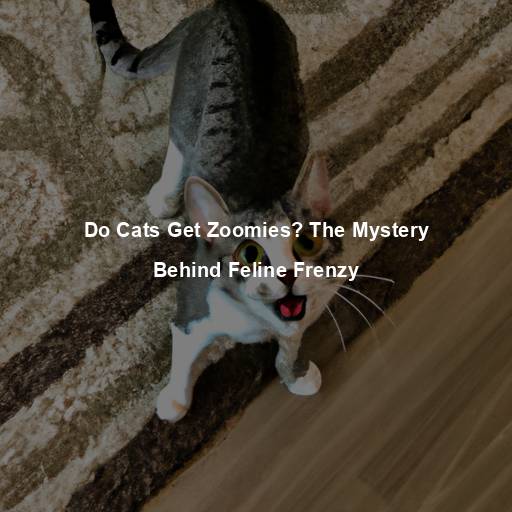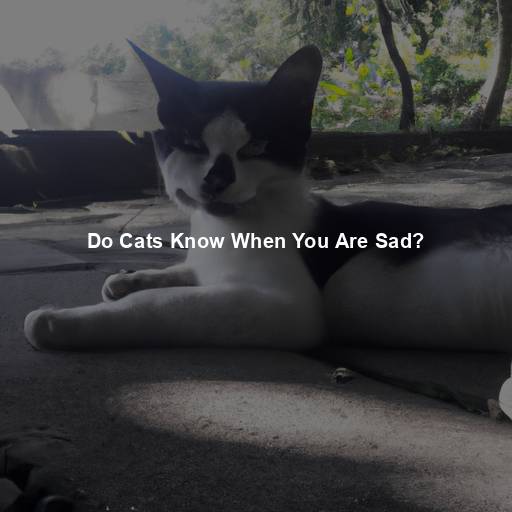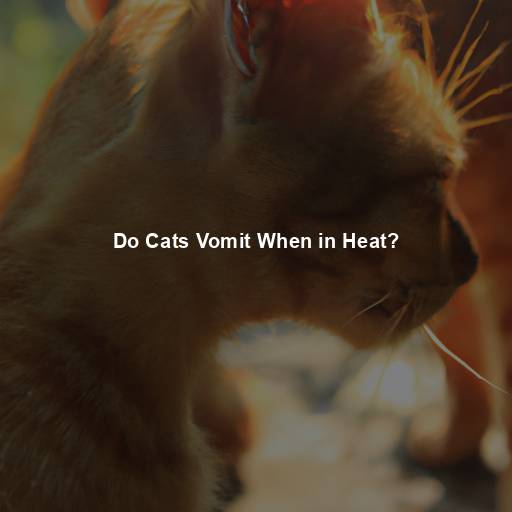Do Cats Get Zoomies? The Mystery Behind Feline Frenzy
Last Updated on October 31, 2023 by Evan
Contents
- 1 Understanding the Zoomies Phenomenon
- 2 Unleashing the Energy
- 3 The Joy of Play
- 4 The Zoomies vs. Underlying Health Issues
- 5 Embracing the Zoomies
- 6 The Enigmatic Zoomies
- 7 The Role of Age and Development
- 8 Environmental Factors and Triggers
- 9 Zoomies or Something More?
- 10 Embracing and Enjoying the Zoomies
- 11 The Zoomies: A Quirky Cat Behavior
- 12 FAQs for the topic: Do Cats Get Zoomies?
Understanding the Zoomies Phenomenon
Cats are fascinating creatures, known for their playful and sometimes quirky behavior. One particular behavior that many cat owners have witnessed is the phenomenon known as “zoomies”. If you’ve ever seen your feline friend dash around the house with lightning speed, seemingly possessed by an invisible force, you’ve experienced the zoomies firsthand. But what exactly are the zoomies, and why do cats engage in this frenzied behavior?
Unleashing the Energy
Burst of Energy
The zoomies, also referred to as the “crazy hour,” are characterized by sudden bursts of energy in cats. During these episodes, cats may sprint, jump, twist, and turn with seemingly boundless enthusiasm, often in a rather erratic and unpredictable manner. These episodes can last anywhere from a few minutes to half an hour, and they tend to occur more frequently in young cats and kittens. So, what triggers these energetic outbursts?
Release of Pent-Up Energy
Have you ever wondered why your furry feline suddenly goes into turbo mode, dashing around the house like a crazed cheetah? It turns out that their ancestral instincts play a major role in this phenomenon. Despite their cozy domestic lives, cats still harbor the innate drive to pounce and stalk; it’s in their DNA, after all. As they accumulate pent-up energy from their low-key lifestyles, these zoomies serve as a pressure valve, allowing our adorable companions to unleash their inner wildcat and bound around the room with perplexing bursts of energy.
Stimulation and Environmental Factors
The call of the wild seizes our feline friends with unequivocal force – the notorious zoomies have infiltrated their graceful beings. What precisely unleashes this uproar of energy, you may ask? A symphony of stimulation, my dear readers. Cats possess an acute perception, enabling them to be tantalized by the slightest environmental nuances.
The Joy of Play
Instinctual Behavior
Beyond the release of energy, the zoomies serve a significant purpose in a cat’s life – play. Play is an essential aspect of a cat’s development, helping them refine their hunting skills, improve coordination, and maintain overall physical fitness. The zoomies can be seen as an expression of a cat’s innate need for play, providing them with an outlet to engage in mock hunting and satisfy their natural instincts.
Social Interaction
Did you know that cats are not only independent hunters but also surprisingly social creatures? It turns out that playtime is much more than just a way to burn off energy for our feline friends. Cats use play as a means of connecting with both their human companions and fellow furry housemates. So, the next time your cat goes zooming around, don’t be perplexed.
The Zoomies vs. Underlying Health Issues
When it comes to the enigmatic world of feline behavior, one phenomenon that both captivates and perplexes cat owners is the infamous “zoomies”. These electrifying bursts of energy seem harmless on the surface, but it’s crucial to unravel the enigma and discern between the normal zoomies and potential red flags of underlying health concerns. Delving into the depths of this enigmatic behavior, we unveil a few key points that shed light on this puzzling occurrence and empower feline aficionados to better understand their furry companions. Buckle up for a journey filled with captivating twists and turns as we dive into the captivating realm of feline zoomies.
Frequency and Duration
Normal zoomies occur intermittently and last for a relatively short period. If your cat’s frenzied behavior becomes excessively frequent or prolonged, it may be worth consulting with a veterinarian to rule out any potential health concerns.
Changes in Behavior
If your cat’s zoomies are accompanied by other changes in behavior, such as aggression, excessive vocalization, or litter box issues, it could indicate an underlying problem. Cats often exhibit changes in behavior when they are unwell, so it’s crucial to monitor these patterns and seek professional advice if needed.
Environmental Stressors
Cats can display unexpectedly wild bursts of energy, known as zoomies, triggered by various stressors within their environment. Disruptions in these feline habitats, such as relocating to unfamiliar dwellings or adding new furry members to the family, can throw their routines into disarray and induce anxiety. Thus, it becomes crucial for cat parents to foster a serene and stable atmosphere that mitigates any potential repercussions arising from stress-related challenges.
Embracing the Zoomies
Provide Adequate Playtime
If you’re struggling to keep up with your feline friend’s wild escapades, fear not! There are some pawesome solutions at hand. Making sure your furry companion gets their daily dose of interactive playtime is key. From engaging them with tantalizing wand toys to challenging them with clever puzzle feeders, you can provide a purrfect outlet for their hunting instincts while ensuring they channel their boundless energy in a more controlled and fulfilling way.
Create a Stimulating Environment
Discover a multitude of captivating playthings, stylish scratching alternatives, and elevated havens to enhance your feline companion’s environment. Empower their curious minds and agile bodies with an array of enriching diversions, ensuring their contentment and minimizing the chances of frenzied bursts of energy.
Establish a Routine
Establishing a consistent daily routine for your cat can provide them with a sense of security and stability. Regular feeding times, play sessions, and quiet periods for rest can help minimize stress and promote a balanced lifestyle for your feline friend.
The Enigmatic Zoomies
Unraveling the secrets behind a cat’s elusive zoomies can feel like deciphering an ancient code. These wild and unpredictable bursts of energy baffle even the most knowledgeable cat owners. But fear not, for there is a method to this madness. Zoomies, it seems, are a natural manifestation of a cat’s innate desire for play, exercise, and social interaction.
Understanding Feline Physiology
Understanding the enigma that is the phenomenon of zoomies requires delving into the inner workings of a cat’s physique. These majestic creatures are equipped with a specialized set of muscles, aptly named fast-twitch muscles, which grant them unparalleled velocity and nimbleness. With these muscles at their disposal, felines possess the ability to execute short bursts of immense energy, whether it be in pursuit of their elusive prey or engaging in spirited playtime. The zoomies, then, can be viewed as a culmination of these fast-twitch muscles in full swing, as our beloved cats dazzle us with their astonishing agility and rapidity during these perplexing episodes.
Neurochemical Factors
When it comes to the zoomies, it’s not just about the physical factors that drive our feline friends wild. The inner workings of a cat’s brain are also at play, with neurochemical processes taking center stage. One key player in this exhilarating frenzy is dopamine, a neurotransmitter known for its role in pleasure and reward. When the zoomies strike, dopamine levels skyrocket, leaving cats feeling an adrenaline-fueled mix of excitement and pure bliss.
The Role of Age and Development
Kittens and Young Cats
Zoomies are particularly prevalent in kittens and young cats. This can be attributed to their high energy levels and inquisitive nature during the early stages of development. Kittens are known for their playful antics, and the zoomies are an extension of their natural inclination to explore, chase, and pounce on objects. As they grow, their energy levels may decrease slightly, but the zoomies can still occur sporadically, especially during moments of heightened excitement or stimulation.
Adult and Senior Cats
Even though we typically attribute zoomies to the youthful exuberance of kittens, it’s worth noting that adult and senior cats are not immune to these lively episodes. As cats grow older, their inclination towards high-energy play may decline, leading to less frequent and intense zoomies. Nevertheless, every now and then, adult cats surprise us with unexpected bursts of energy, a gentle reminder that the playful nature of a feline never truly diminishes.
Environmental Factors and Triggers
Environmental Enrichment
Creating a thriving living space for our feline friends is pivotal in nurturing their holistic health and demeanor. Elevating their quality of life through thoughtful environmental enrichment becomes the key to warding off monotony and embracing cerebral and physical engagement. From interactive playthings to enticing scratching havens, from lofty climbing wonders to brain-teasing food puzzles, we can curate a captivating realm that satiates their instinctual cravings and curbs any chance of endless zoomies.
Stimulation and Interaction
Cats are curious creatures that thrive on stimulation and interaction. Engaging in regular play sessions with your cat, using toys that mimic prey, can help channel their energy and provide a healthy outlet for the zoomies. Additionally, spending quality time with your feline companion through gentle petting, grooming, or interactive play can strengthen the bond between you and reduce any anxiety or restlessness that may contribute to the zoomies.
Zoomies or Something More?
While the zoomies are generally harmless, it’s essential to differentiate between normal zoomies and potential underlying health issues. Here are some signs that may indicate a need for further investigation:
Unusual Patterns
Have you ever had a case where your furry friend decides to go on a wild sprint around the house, seemingly out of nowhere? It can be quite amusing to watch, but what if this behavior becomes a regular occurrence or happens at peculiar times? Well, don’t brush it off as mere entertainment; it could be a red flag signaling something more serious. Keeping a close eye on your cat’s behavior and seeking professional advice from a veterinarian is the purr-fect way to ensure their well-being.
Pain or Discomfort
Cats may display frenzied behavior as a coping mechanism for pain or discomfort. If you notice any signs of distress, such as limping, vocalization, or changes in appetite, it’s crucial to seek veterinary care to address any potential medical issues.
Stress and Anxiety
The wild roller coaster known as the “zoomies” isn’t always just a burst of energy. Believe it or not, environmental stressors can take this feline phenomenon to a whole new level. Whether it’s relocating to a swanky new crib or bringing in a new furry friend, cats can feel the pressure and unleash their inner confusion and perplexity. But fear not, dear cat lovers!
Embracing and Enjoying the Zoomies
The zoomies are a natural and entertaining aspect of a cat’s behavior. Instead of trying to stop or control these episodes, it’s important to embrace and enjoy them. Here are some ways to make the most of the zoomies:
Safe Space
When it comes to your feline friend, it’s crucial to create an environment that embraces their playful nature while keeping them out of harm’s way. By decluttering the space and safeguarding delicate items, you can prevent any untimely mishaps during their adventurous zooming sessions. Additionally, adding cushioned surfaces will add an extra layer of protection, ensuring their landings are soft and secure.
Observation and Appreciation
Take a moment to observe and appreciate your cat’s agility and grace during the zoomies. Their lightning-fast movements and acrobatic leaps are a testament to their innate abilities and natural instincts.
Capturing the Moment
Have you ever been fortunate enough to witness the wondrous phenomenon known as the zoomies? If so, you would be wise to seize the opportunity and immortalize this exhilarating display through the lens of your camera or video recorder. The sheer delight and amusement that these impish antics bring not only to you but also to those fortunate enough to catch a glimpse are truly awe-inspiring. Step into the captivating world of your feline companion’s boundless energy and prepare to be enthralled by their playful bursts of perplexity and joy.
The Zoomies: A Quirky Cat Behavior
In conclusion, the zoomies are a fascinating and unique behavior exhibited by cats of all ages. Whether it’s a kitten dashing through the house or an adult cat playfully pouncing on imaginary prey, the zoomies are a delightful reminder of the joy and exuberance our feline friends bring into our lives. By understanding the underlying factors and providing appropriate outlets for their energy, we can embrace the zoomies as a cherished part of the feline experience. So, the next time your cat gets the zoomies, sit back, relax, and enjoy the show as they race through the room, reminding us of the boundless spirit and untamed nature of these magnificent creatures.
FAQs for the topic: Do Cats Get Zoomies?
What are cat zoomies?
Have you ever witnessed your feline friend transform into a whirlwind of energy and mischief? These delightful phenomena, known as cat zoomies, introduce us to a world where gravity and reason hold no sway. In the blink of an eye, our beloved companions morph into acrobats, sprinting and leaping with unparalleled agility and enthusiasm. These unexpected bursts of vitality can strike at any moment, leaving us both perplexed and captivated by their seemingly boundless energy.
Why do cats get zoomies?
Cats and their unpredictable behavior have always left us scratching our heads in wonder. The phenomenon known as “zoomies” is no exception. The reasons behind these rapid bursts of energy seem to be as varied as the cats themselves. Some experts believe it harkens back to their innate hunting instincts, a way for them to simulate the chase and exploration of their wild ancestors. Others suggest that zoomies may be triggered by a surge of adrenaline, sparked by something as simple as a new toy or the presence of a fellow feline. Whatever the cause may be, one thing is certain – when it comes to cats and their zoomies, expect the unexpected.
Are cat zoomies normal?
The captivating phenomenon known as cat zoomies remains an enigma, enchanting and puzzling feline enthusiasts the world over. These wild and unpredictable spurts of energy, so peculiar to our whiskered companions, serve as a window into their untamed souls. Embracing this delightful display of agility and fervor, our feline friends embark on a whirlwind adventure, a momentary escape from the confines of our domestic realm. As long as these spirited antics remain harmless and untainted by malevolence, we can bask in the joy and bewilderment of cat zoomies, a peerless spectacle that forever leaves us guessing what lies beneath the surface of their enigmatic nature.
How often do cats get zoomies?
The frequency of cat zoomies varies from cat to cat. Some cats may have zoomies several times a day, while others may experience them less frequently. The occurrence of zoomies also depends on factors such as a cat’s age, breed, overall health, and environmental stimuli. Kittens and younger cats tend to have more frequent and intense zoomies, while older cats may have less frequent zoomie episodes.
Can I help my cat during zoomies?
When your feline friend suddenly becomes a blur of energy, don’t fret! Embrace the perplexing phenomenon known as the zoomies by granting them the space to frolic and indulge in their natural playfulness. Of course, it’s crucial to safeguard your delicate possessions from any unexpected roughhousing. Consider spicing up their playtime with interactive toys that cater to their predatory instincts, like feathered wonders or the elusive laser pointer. Just remember to create a secure environment that allows them to navigate freely, avoiding any puzzling obstacles along the way!
Should I be concerned if my cat’s zoomies seem excessive?
In most cases, excessive zoomies are not a cause for concern. However, if your cat starts displaying extremely frequent or overly intense zoomies that seem out of the ordinary, it may be wise to consult with a veterinarian. Occasionally, excessive zoomies can be a sign of underlying health issues, stress, or anxiety. A vet can help determine if there is an underlying cause for the excessive zoomies and provide appropriate advice or treatment if necessary.
Can cat zoomies occur at night?
Have you ever experienced the mysterious phenomenon of cat zoomies in the dead of night? It turns out that our feline friends are notorious for their unpredictable bursts of energy, especially during those magical twilight hours. These crepuscular creatures simply can’t resist the allure of the night, which is why they often exhibit their most bewildering and perplexing behavior at these unconventional times. So, if you find yourself in the midst of a feline frenzy when all seems calm, try engaging your cat in interactive play or providing them with stimulating puzzle toys to channel their inner hunter and potentially curb their nocturnal antics. The key is to unlock the mysterious allure of the night and channel it in a way that keeps both you and your furry companion content during these perplexing moments.
Do all cats get zoomies?
Cats, those enigmatic creatures of feline majesty, possess a fascinating array of behaviors that bewilder even the most ardent feline admirers. Amongst these mysteries is the phenomenon known as the “zoomies,” a display of wild and untamed energy that some cats engage in with fervor. However, it should be noted that not all cats partake in this exhilarating pursuit, for each feline soul possesses its own distinct personality, energy, and idiosyncrasies. Whether your beloved whiskered companion dashes through the halls with unabashed zeal or prefers a more serene existence, it is crucial to embrace their individuality and respect their unique proclivities.






